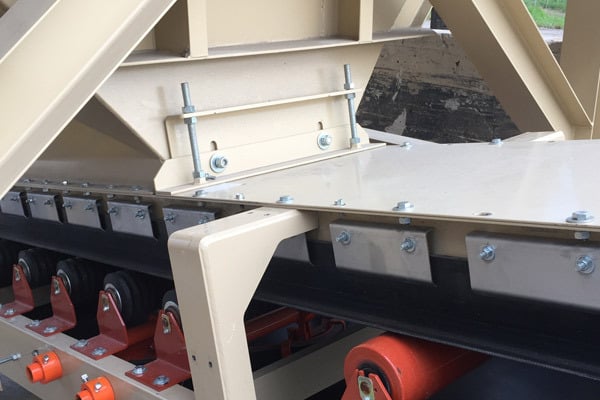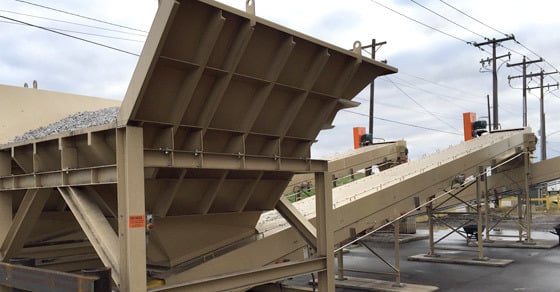As one of the most cost-effective ways to transport material in and around a facility, belt conveyors are employed in every industry working with bulk solids. Their diverse handling capabilities combined with flexible design makes them an essential tool in nearly any setting. But conveyors have one downfall: they cannot control material feed rate.
Controlling the flow of bulk materials is critical to achieving streamlined, efficient production; without a controlled feed rate, bottlenecks, inferior product, shutdowns, and a host of other production issues quickly become commonplace.
As such, belt feeders are used in bulk solids handling and processing operations to properly control material flow by metering material into a process or piece of equipment. And while belt feeder design is based on many of the same parameters that are required for designing a belt conveyor, belt feeders must be designed with a few additional criteria in mind to reach a reliable, effective feeding solution.
Belt Feeder Applications
The precise control belt feeders lend to bulk solids handling makes them useful in a diverse range of applications. Capable of handling everything from sand to ore, belt feeders are especially critical when working with bulk solids that exhibit poor flowability. They are often found in the following settings:
- Pulp and paper mills
- Power generation plants
- Mining and mineral processing operations
- Fertilizer production and blending plants
- Chemical production facilities
- Aggregate handling operations
How Belt Feeders Work
A belt feeder consists of a hopper positioned directly over a belt conveyor. The belt conveyor “pulls” material out from under the hopper, while an adjustable vertical strike-off plate controls the height of material allowed to advance as the belt moves forward, or in other words, the material profile on the belt. Skirt boards contain material on the belt.
Belt feeders operate at much slower speeds compared to regular troughed belt conveyors – typically in the range of 30-60 FPM and usually not exceeding 100 FPM.

Close-up of a belt feeder with adjustable vertical strike-off plate and skirt board system
Using A Belt Feeder to Control Material Feed Rate
Feed rate is controlled by adjusting two variables: strike-off plate height and belt speed.
Strike-off Plate Height
The strike-off plate height refers to the height above the conveyor to which the strike-off plate is set. Strike-off plate height is primarily dictated by the particle size of the material being dispensed, with larger particle sizes requiring more height.
The higher the strike-off plate is set, the more material that is dispensed onto the belt, so by increasing or decreasing the plate height, the flow rate can be increased or decreased.
Belt Speed
Conveyor belt speed, or the speed at which the belt passes under the hopper, also acts as a measure to control feed rate. By increasing belt speed, flow rate is also increased.
Strike-off plate height and belt speed are adjusted in tandem to find the right balance between the desired flow rate and the amount of material the conveyor belt can handle.
Factors to Consider in Belt Feeder Design
Several factors influence belt feeder operation and reliability:
Head Load
Head load is the single most important factor in belt feeder design. The head load is the amount of pressure put on the belt directly under the hopper opening as a result of the weight of the material resting on the belt. The head load is determined by the material’s bulk density, in combination with the hopper dimensions and configuration.
In addition to defining the level of structural support required, the head load is used to determine the amount of horsepower required to move the belt. The greater the head load, the more horsepower required, and the larger the motor and associated components must be.
If a conveyor were undersized for the head load, the feeder would not run, because the motor would over-amp and stall out. Oversizing a belt feeder might seem like a better option, but is inefficient and consumes more energy than is necessary.
Because a greater head load requires the use of more robust components, thereby increasing the capital expense, it is often desirable to try to minimize the head load on the conveyor.
Head load can be reduced in a few different ways:
Add a structural member to the hopper interior
A steel structural member, sometimes called a “top hat,” can be added to the interior of the hopper to take some of the material weight off of the belt, reducing the head load.
Use an angled hopper
When replacing a straight-edge hopper, the edges of an angled hopper can assist in supporting the material load, reducing the burden of weight on the belt conveyor.
Use a smaller hopper
Since the head load is largely determined by the hopper dimensions, by reducing the size of the hopper opening (and/or the height of the hopper), the head load is thereby also reduced. Belt speed can then be increased to achieve the same capacity.
By decreasing the head load, a lower horsepower and lighter-duty components can be used, lowering the cost of the unit while still achieving the same capacity.

Conveyor belt feeder with hopper transition piece in production at FEECO International
Skirting
While feed rate is primarily a result of belt speed and slide gate height, skirt boards, or skirting, can be used to increase the feed rate capacity.
Skirt boards serve to contain material on the belt by providing additional structure for material to rest against. This often allows operators to “over fill” the conveyor and reach a higher capacity. However, this must be carried out with caution, as the next conveyor must also be capable of handling the load, and since it is not cost-effective to fully skirt long conveyor spans, the conveyor following the belt feeder is typically not skirted and will not be able to contain as much material, though the increased speed of this conveyor helps to make up for this.
VFDs
Since belt speed is a primary factor in adjusting feeder flow rate, a variable frequency drive, or VFD, is an essential component of the belt feeder.
The VFD allows operators to adjust belt speed in response to changing particle size or fluctuations in capacity during startup or shutdown. Were a VFD not utilized, operators would have no control over belt speed and would be limited in their adjustments by the strike-off plate, which itself is limited by the maximum allowable height adjustment.
Belt Scale
The conveyor following the belt feeder commonly employs a belt scale. A belt scale weighs the material on the conveyor in order to confirm the desired feed rate.
Belt scales are particularly useful when material is prone to flow problems such as ratholing, as it can help to indicate when a reduction in feed rate has occurred.
Conclusion
Belt feeders bring precision control to material feed rate in nearly any operation handling bulk solids, but they require a few special considerations to achieve a lasting, efficient feeder.
FEECO bulk handling systems are engineered around the specific process and material goals to provide the best possible handling solution. All FEECO belt feeders, conveyors, and other bulk handling equipment are highly customizable and have a reputation for reliability. For more information on our bulk handling equipment and systems, contact us today!



